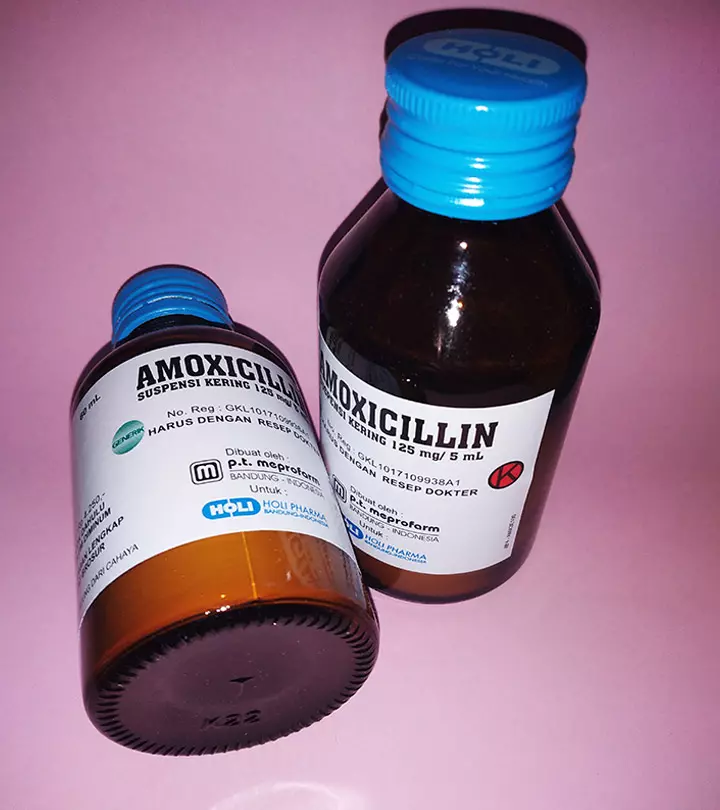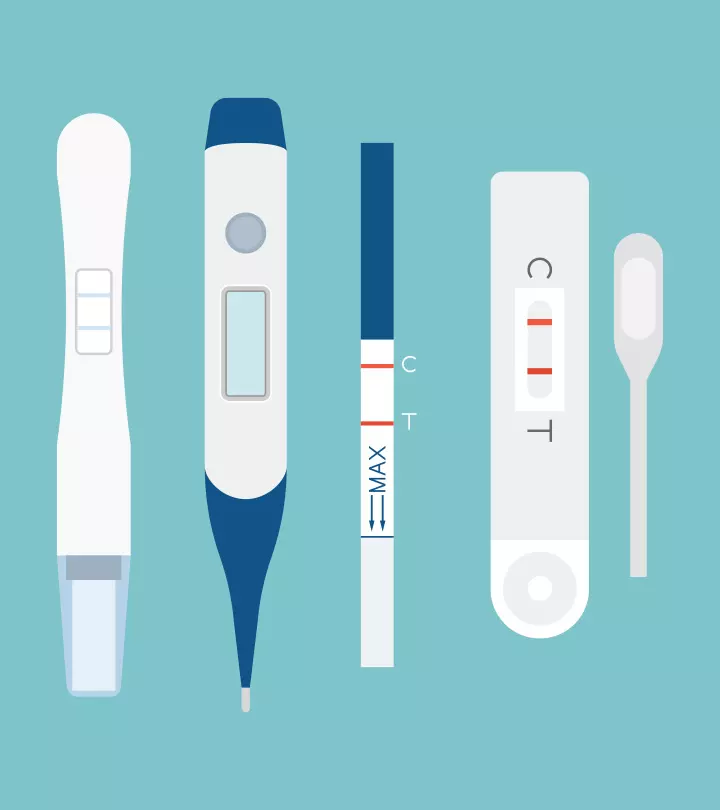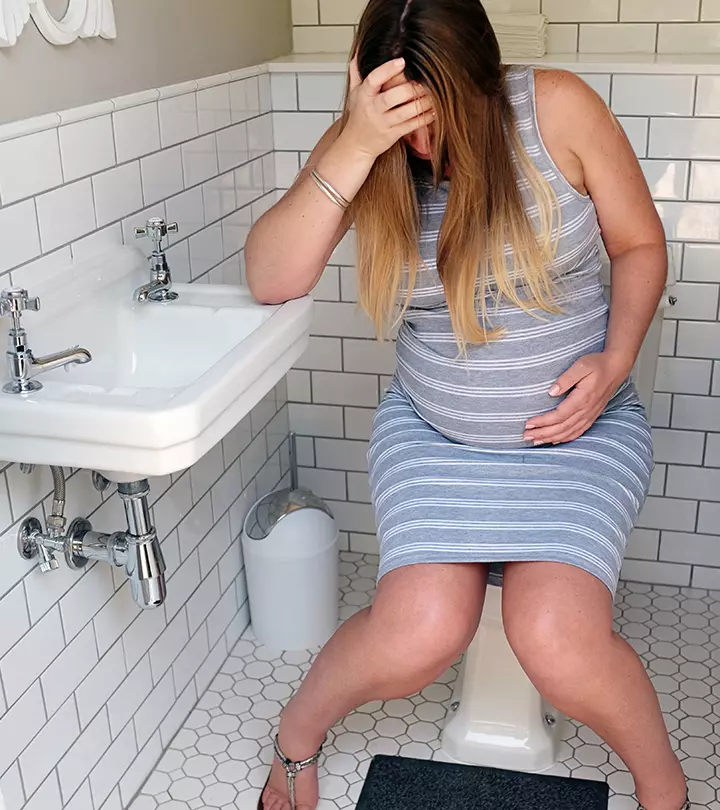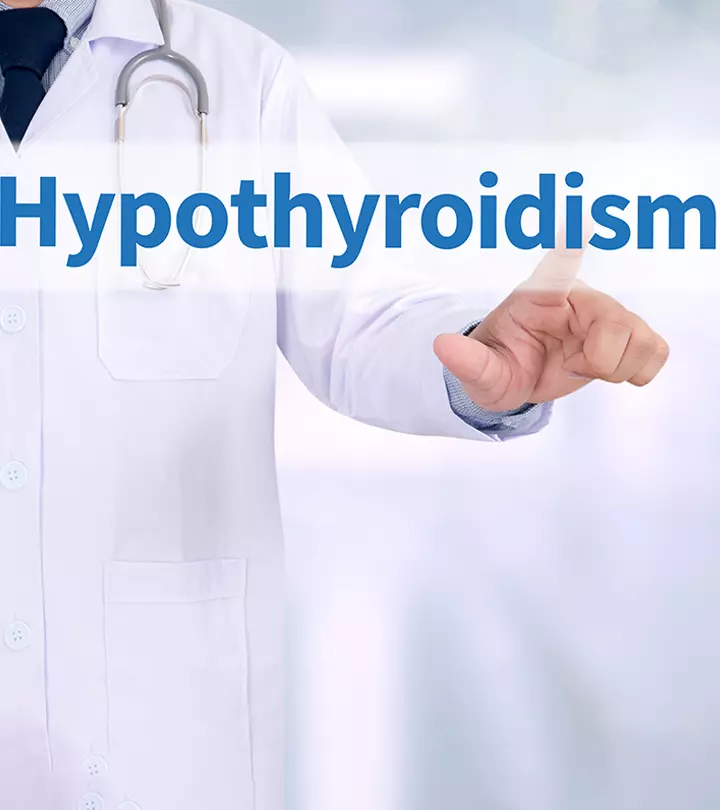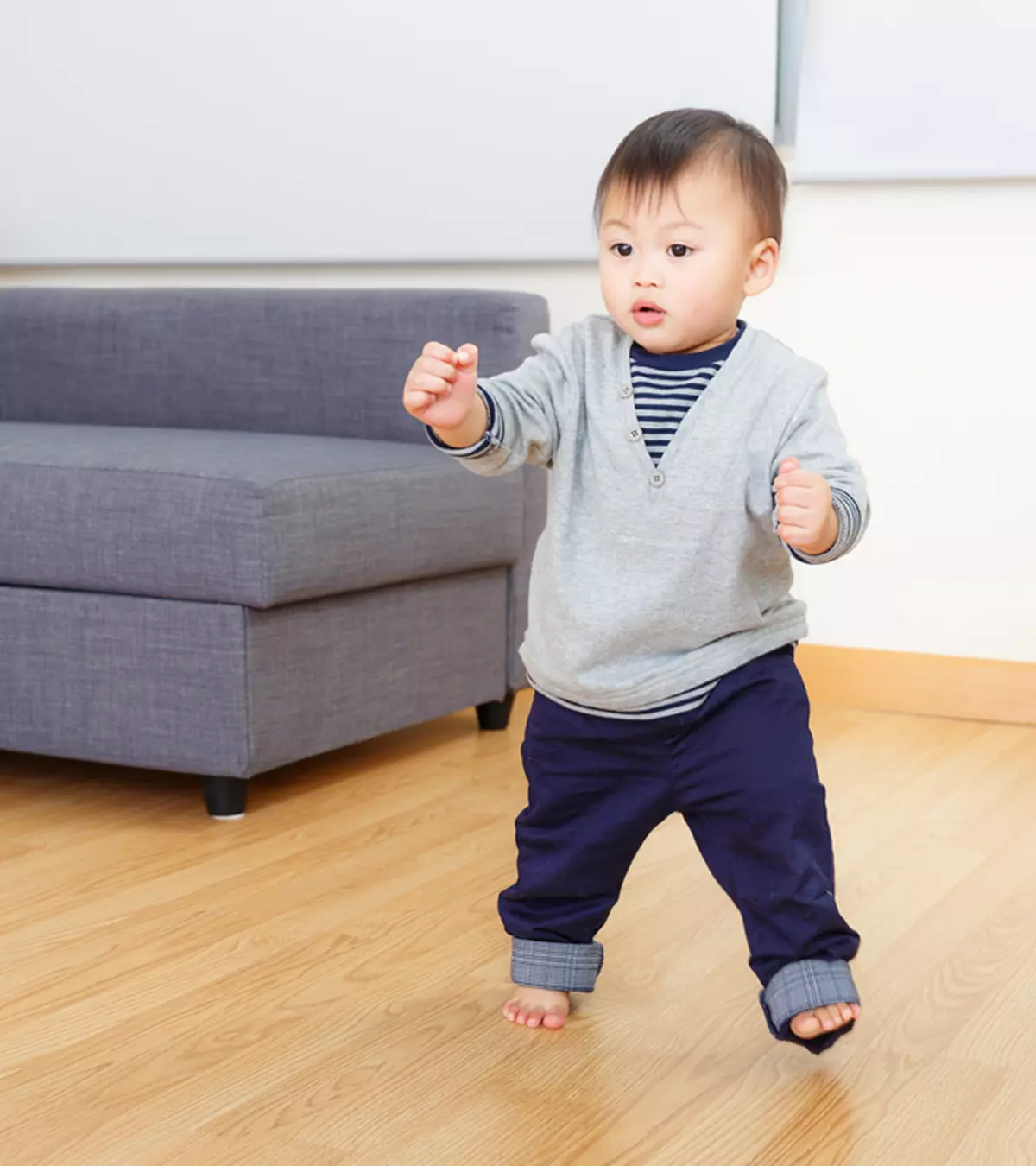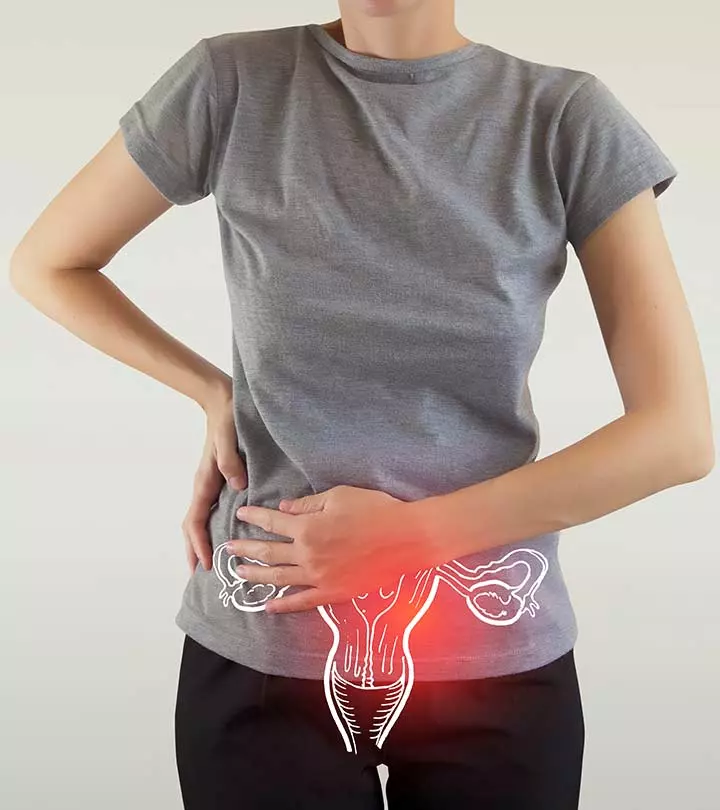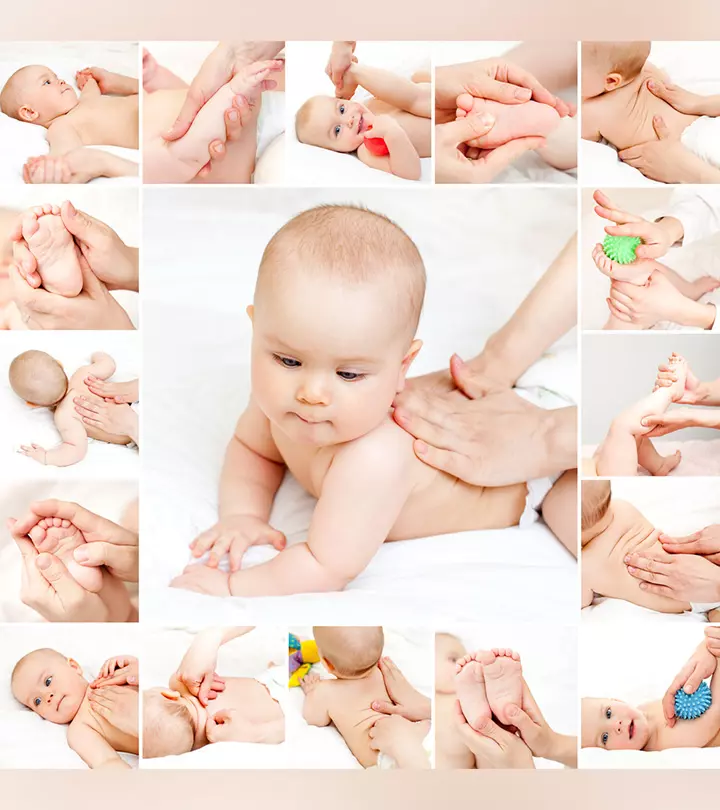
Image: Shutterstock
Massages are beneficial and therapeutic for babies and may help improve their blood circulation and aid in their overall development. In this post, we tell you about the benefits of baby massage and how to massage a baby the right way.
The result of a study published in the Journal of American Academy of Pediatrics suggests that a massage is compared to a crib vibrator and helps calm colicky babies (1). This nurturing practice can also create a calming environment and help babies feel more secure and loved. Moreover, the massage time can also be an intimate bonding time for you and the baby.
Learn about the benefits of massaging babies and a few safe massaging methods in this post.
Key Pointers
- Massages can benefit babies’ overall growth and blood circulation.
- A massage can help relax colicky infants and promote parent-child interaction.
- It is suggested to wait until a newborn is at least one month old before beginning massages, although there are no set age limits.
- Massaging a baby can lead to stress reduction, muscle and neurological system growth stimulation, improved sleep, and support for the development of babies with special needs.
- Infant massage can benefit specific medical issues such as constipation, gas and colic, cough and congestion, gastric reflux, hiccups, jaundice, immunizations, and teething.
When To Start Baby Massage?
There are no set guidelines regarding the minimum age to start massaging a baby (2)
. There is a general opinion that infants must complete one month of their life before they get a massage. The reason for this is that a baby’s skin barrier is underdeveloped at birth, and it takes 15 days for the skin to become water-resistant (3).
At about 15 days of age, babies shed their umbilical cord stub. Until then, it can be an infection hazard if any massage oil gets trapped in it. If you plan to take your baby to group massage sessions, then it is advised to wait until the baby is six weeks old since very young babies can find crowded environments stressful.
Overall, one month is the ideal age since it has multiple benefits: the umbilical cord stub would have fallen, and the navel had dried, the skin is less sensitive than at birth, the skin barrier is stronger, and the baby at this age can be more responsive to touch.
Benefits Of Baby Massage
Pediatric massage provides several natural benefits to the baby.
- Relieves stress, relaxes muscles: Massage relieves stress in babies by stimulating the release of oxytocin, a feel-good neurohormoneiHormone secreted by the neuroendocrine cells, functioning as transmitters and messengers for various chemical reactions. , and decreases the levels of cortisol, a stress hormone (4). The relaxation techniques soothe muscles, stimulate their growth, and even work particularly great with colicky babies. Touching your baby during massage calms them down and encourages stress relief and colic relief.
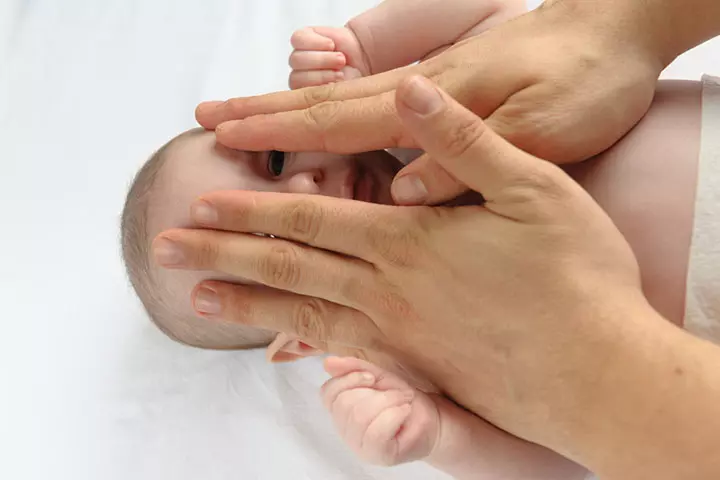
- Stimulates nervous system: Massage is beneficial to the baby’s nervous system since it greatly improves the baby’s motor skill development.
- Helps baby sleep better: Massage is one of the calming techniques that makes babies sleep better. This has several benefits from faster muscle gain to improved immune response. Infants who are massaged just before bedtime produce more melatonin – a sleep-regulating hormone (5).
- May improve the quality of life for differently-abled babies: The soothing techniques could help relax babies with Down’s syndromeiA genetic condition where an extra 21st chromosome affects the facial features and causes speech and language problems. or cerebral palsyiA neurological disorder affecting a person's ability to move, balance, and maintain posture. (2). Premature babies show better motor development when massaged regularly. They even gain weight faster than premature babies that are never massaged.
 Research finds
Research findsIn fact, massaged premature babies have shorter hospital stays. Babies born to depressed mothers, when massaged, cried less and showed greater emotional and social development as they grew.
- Could help improve blood circulation: Massage improves the blood circulation and also decreases the level of discomfort caused by gas or acidity, congestion, and teething (6). Massage stimulates the nerves that pass through the digestive tract, thus benefiting the digestive system.
- Way to deal with postnatal depression: Massage could be an effective way to deal with postnatal depression among mothers. Depressed mothers showed improved mood and behavior when they massaged their babies regularly.
 Point to consider
Point to considerResearch has also shown that fathers who regularly massage their babies develop improved self-esteem. They also display increased involvement in baby’s care and interact with babies more frequently (7).
- Boosts psychological and social development: According to a 2012 report by Asian Nursing Research Journal (8), stimulation of the baby’s sense of touch has a positive effect on the baby’s psychological and social development along with strengthening the baby’s bond with the parent.
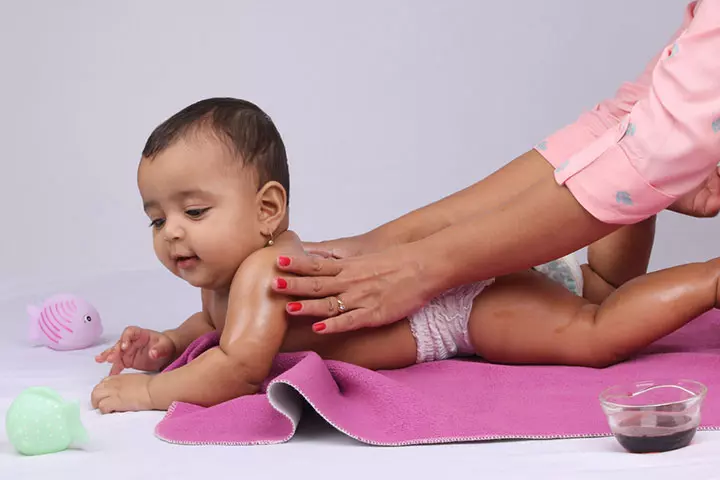
Best Time To Massage Your Baby
The best time to massage a baby is when they are alert, well-rested, and seem interested in the environment.
Select a moment right between two feeding sessions when the baby is less likely to feel full or hungry. There should be a gap of at least 45 minutes from the baby’s last feeding session. Also, wait for 15 minutes after the massage before feeding again to give the baby’s body some extra time to relax completely.
When it comes to a specific time for massage, you can stick to massage after a bath, when the baby is just about to be tucked into the bed for the night or for a nap. Baby massage before a bath is the ideal since you can wash away the oil during the bath to prevent the accumulation of residual oil or lotion on the baby’s sensitive skin. You may choose to massage your baby after bath in case they have extremely dry skin or if your pediatrician has given a green signal to it. Generally, you’ll notice the greatest benefit if you can stick to a regular bedtime routine of massaging the baby at night.
Which Oil To Use For Massage?

The UK NHS does not recommend using oil or lotion for massaging the baby until they turn one month old (9). This is done to avoid moisture loss from the baby’s skin, which is very delicate at the time of birth. However, during the first month (or longer in case of a premature baby), your baby’s skin develops its natural protective barrier. Owing to this, the baby’s skin becomes relatively thick. This is the time, under the consultation of a pediatrician, when you could start massaging your baby.
For babies over one month, you may use any odorless and edible oil so that there may not be a problem even if the oil is ingested by mistake. Consult your pediatrician to know about the most suitable oil for your baby.
How To Massage A Baby?
There are no set guidelines on specific steps of massaging. But before you get down to the process of massaging the baby, you need to set up various things.
Setup For Massage
Start your baby massage with the following setup:
- Ensure the room is quiet and free of distractions. You may play soft music or gentle sounds to enhance the atmosphere and make the experience enjoyable for you and your baby.
- Sit on a bed or soft carpeted floor with a towel in front of you. You can also place a towel on a table to massage your little one while you stand. The towel helps absorb excess oil.
- Maintain a comfortable room temperature. During winters, ensure that the room is warm and during summers make sure there is ample circulation of cool and fresh air in the room. Babies do feel warm quickly and tend to become cranky.
- Lighting in the room is important and use as much natural light as possible.
- Choose a massage oil that is specifically made for babies. Select unscented oils, with natural fragrances and no added perfumes.
- You can choose to massage your baby with or without the nappy, but you can loosen it when massaging his tummy. Massaging without nappy may increase the risk of accidental soiling, but it also ensures that you massage every part of the baby’s body.
Let’s now see how to massage a baby in the right way. Here is a step-by-step guide:
Step 1: Seeking the permission
The first step is to take your baby’s ‘permission’ since you would not like to give them a massage when they are not interested. The simple way to do this is by taking some oil in your palms and rubbing it gently on the baby’s tummy and behind the ears and observing their body language. If the baby resists being touched or grumbles and cries when massaging, then it is probably not the right time yet. If the baby shows positive signs and seems okay with what you are doing, then you can go ahead with the massage.
Keep in mind that, initially, your baby may seem uncomfortable with the massage as it is a new experience. Use gentle pressure and be attentive to your baby’s cues. As they get used to it, resistance is less likely, and they may start to enjoy it.
Step 2: Massaging the legs
- Start with the baby’s feet. Rub some drops of oil on your palms and begin massaging the baby’s soles. Massage the heels up to the toes with your thumbs. Then, using your palm, stroke the bottom and top of the baby’s foot. Slowly, make circles with your thumb all over the bottom of each foot and then to the toes. Do not pull any toe like they do in adult foot massage. Instead, lightly massage each toe right to the tip. This will help stimulate nerve endings.
- Lift one of the legs and make gentle strokes on the ankle and slowly extend it towards the thighs. Gently stroke from the foot up to the thigh. You can also massage both legs at once if your baby is calm and relaxed.
- You end the leg massage by gently grasping the thighs with both your hands. Slowly stroke toward the heart from foot to thigh.
Step 3: Moving to the arms
- After the legs have been massaged, the arms should be massaged. The pattern of massaging is quite similar to that of the legs. Hold the baby’s hands and make circular strokes on the palms. Slowly make small strokes on the baby’s fingers, moving towards the tips of the fingers.
- Turn the baby’s hand around and now gently massage the back of the hand with straight strokes towards the wrist. Then, gently massage the wrists in a circular motion, like putting on bangles.
- Move your strokes slowly towards the forearm and then towards the upper arm. Massage the entire arm with gentle circular motions as if you are wringing a towel.
Step 4: Chest and shoulder massage
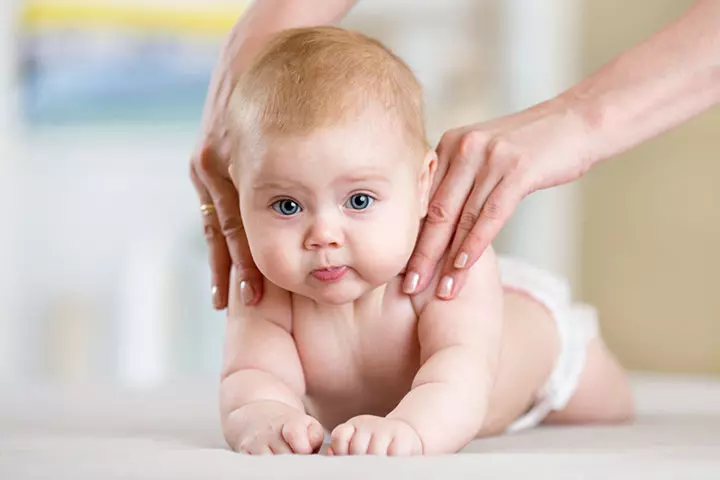
- Make gentle strokes in tandem from the left and right shoulder towards the chest of the baby. You can then trace your hand back to the shoulder. Repeat the motion gently. Next, place both your hands at the center of your baby’s chest and rub outwards from the body – towards the lateral side.
- Make gentle strokes outwards from the bottom of the sternum, the chest bone, across the chest, as if tracing the shape of the heart.
Step 5: Time for tummy massage
- Next comes the baby’s stomach. Remember, this is a delicate area, and therefore you must avoid even the slightest of pressures. You start your stroke from the top of the belly right below the chest bone. Place your palm gently below the chest bone and make clockwise circular strokes across the belly – all around the belly button. Do not apply any pressure and let your hand gently glide across the belly.
- Continue the circular motions in a clockwise direction while avoiding the belly button. In young babies, the belly button/navel can be sensitive and delicate since they would have recently shed their umbilical cord stub.
Step 6: Massaging face and head
- Massaging the face and head can be challenging since babies tend to move a lot. But it is as important as massaging the other parts of the body. Begin by placing the tip of your index finger at the center of your baby’s forehead and slowly stroking along the outline of the face towards the chin. From the chin, move your finger towards the cheeks and massage the cheeks gently in a circular motion. Repeat the strokes a few times.
- After massaging the face, start massaging the scalp with the fingertip like you are shampooing the baby’s hair. Use gentle pressure from your fingertip and do not apply any extra pressure since the baby’s skull is delicate.
- You can even massage the baby’s forehead gently by moving your fingers outwards from the center of the forehead.
Step 7: The back
- The last step is to turn your baby around and massage the back. Place your baby outstretched on the tummy with the hands at the front and not on the sides.
- Place your fingertips on the baby’s upper back and trace clockwise circles while slowly moving the strokes towards the buttocks.
- You then place your index finger and middle finger on either side of the upper spine and very gently move the fingers all the way to the buttocks. Repeat the strokes a few times. Do not place the fingers on the spine. Instead, place two fingers on either side of the spinal groove and run them down.
Massage the baby’s shoulder blades with gentle clockwise circular strokes. Make the same gentle strokes at the baby’s lower back and buttocks. End the massage with this last stroke. Apart from the above-mentioned baby massage techniques, there are a few other effective massages for the baby that work great in certain situations or conditions.
Conditions Where A Massage May Be Beneficial
There could be certain medical conditions or situations where a baby can gain relief through massages
. Here are some scenarios where you can consider massaging your baby to promote infant development.
1. Constipation, gas, and colic
The ‘I love you’ massage is a suitable massage to give when your baby is suffering from constipation, gas, or is coliciFrequent, prolonged, and intense periods of crying in a healthy baby without any apparent reason. . Research proves that infant massage could work great in easing the symptoms of colic among babies (10).
This is a variation of the standard tummy massage that can help tackle multiple problems. Start by placing the baby on their back. Use your fingers to trace a straight line on the right side of the navel. This forms the letter ‘I’. Then, place your fingers at the upper left corner of the belly to trace a horizontal stroke towards the end of the left ribcage.
Trace a vertical straight-line stroke, exactly like the ‘I’ stroke. This forms the letter ‘L’. Next, place your fingers at the lower-left corner of the belly and trace a letter ‘U’ around the navel towards the baby’s lower-left corner of the tummy.
This massage helps your baby poop well and could provide relief from gas-related pain. It is also a suitable tummy ache massage for babies since the pattern of the letters in the massage follows the layout of the intestines within. It stimulates the intestines to ease gas and constipation (11), which could cause pain and discomfort to the baby.
Jessica Hover, a mother of two, shares her advice in her vlog about handling her daughter’s gas problems. She explains, “If they (baby) appear to be struggling with gas, you can lay them on their back and gently pump their legs, which can help release the trapped gas. Another technique is to bicycle their legs. I also find that massaging the tummy in a clockwise motion can aid in moving the gas out (i).”
2. Cough and congestion
Massage could also help the baby feel better when they are suffering from congestion, cough, and cold. Here are the steps to follow:
Step 1: Start by rubbing some oil or lotion on the palm of your hand. This makes your hands warm, soothing the baby as you massage. Rub your baby’s chest using both your hands by starting from the center to the outside using small circular strokes. Then rub the entire chest in circular motions using just one hand.
Step 2: Now, focus on the baby’s face. Here, you massage the sinuses by gently running your fingertips from the inner end of the eyebrow down to the nose and then to the cheek. Repeat this motion a couple of times. This could help release any accumulated mucus present in the sinuses.
Step 3: Lastly, you massage the baby’s feet, focusing primarily on the sole. Massaging the sole could help in generating heat that can help loosen mucus within the chest.
The feeling of warmth could relieve the heavy feeling of congestion in the chest caused by cold and repeated cough.
3. Gastroesophageal reflux
If your baby has acid reflux, then they may have trouble lying flat on the ground. In such situations, place a pillow under their upper back. Place the pillow in a manner that the baby lies at a 45-degree angle. Then give the baby a tummy massage with the same steps mentioned above. Regular massages in a baby with chronic reflux has been clinically proven to reduce the symptoms and give the baby relief (12).
4. Hiccups
Massage could be helpful when your baby is having bouts of hiccups. Hiccups occur when the irritated nerves of the abdominal cavity cause fluttering of the diaphragm due to accumulated gas or due to excessive intake of air during breastfeeding. A massage could help de-stress the tensed diaphragm, thus mitigating hiccups.
When massaging to rid your baby of hiccups, put the baby in an upright position, and massage the baby from the lower back all the way to the shoulders in gentle circular motions. You can do this by placing the baby on their tummy. Do not apply a lot of pressure while massaging.
5. Jaundice
Post consulting your pediatrician, you can follow the aforementioned massage procedure if the baby is suffering from jaundice. Body massage for jaundiced babies has been clinically proven to improve the defecation rate and reduce the amount of bilirubin, which is the compound that causes yellowish skin in jaundice (13). Massage, however, does not cure jaundice in babies. It just alleviates the symptoms and associated discomfort caused by jaundice, thus making the baby feel better.
6. Vaccinations

It may sound surprising, but local massage after vaccination in babies could have significant benefitse. Firstly, massaging the area around the point of injection can help relieve pain and make the baby feel better. Secondly, it helps improve the immunogenicity of some vaccines, which is the body’s ability to produce antibodies against the antigen for which the vaccine has been given. This case has been clinically proven for the diphtheria-tetanus-pertussis vaccine (14).
Never massage directly at the point where the vaccine was injected. Instead, focus on the surrounding areas by massaging gently with soft and smooth strokes.
7. Teething
Massaging your baby’s gums when the baby is teething is a good way of alleviating the pain and irritation (15). Simply wash your hands thoroughly and wipe them dry. Then use your clean fingers to massage the bottom of their gums gently. Do not apply any pressure nor massage the top of the gums where the tooth would erupt. Only run your fingers gently at the base of the gums and continue doing so all along the gums.
Focus on the gums at the front since that is where the first teeth would emerge. You can try this massage when you feel your baby is irritated due to teething.
How Often Should You Massage Your Baby?
There is no restriction on how less or more you can massage your baby. It is great, though, to have a fixed massage routine since it helps your baby reap all the long-term benefits of massage. If your baby faces certain adverse medical problems, then consult the baby’s doctor about the ideal massage routine.
Baby Massage Tips
Here are some important points to remember about massaging your baby (2):
- If, at any point during the massage, your baby becomes cranky, then just skip that massage step and move to the next one. If the baby is still irritable, then stop the massage. You can make an attempt at massaging later when the baby seems more receptive to touch.
- Always be gentle during a massage. Never apply too much pressure on the baby’s body since their bones and tissues are very delicate. Also never massage the genitals or around the groin area.
- Speak, laugh, and smile while massaging your baby. When the baby looks at you, initiate eye contact and talk with a smile. This will help keep the baby interested in the activity, eventually making them more cooperative.
- When done, wipe away the oil on the baby’s palms and fingers using a tissue paper. This is to prevent the baby from accidentally ingesting the oil when they put their fingers in their mouth. It is for this reason, choose baby massage oils that are 100% safe for babies and do not pose any health risk even on accidental ingestion.
- Maintain a fixed time for the massage. This will help establish a routine, making a baby more comfortable during a massage.
When Should You Stop Massaging The Baby?
There is no fixed age to stop massaging. You can choose to massage the baby as long as you want. Many mothers stop the massage when their little one is completely weaned and has transitioned from a baby to a toddler. Some continue massaging their children as they grow and use different techniques to suit their changing needs.
What Are The Benefits Of Baby Massage For Parents?
If you regularly massage your baby, it may be beneficial for you as well (16):
- Improves your confidence in your daily baby care routine
- Strengthens your bond with your baby and helps them achieve healthy attachment
- Enables you to read your baby’s cues and discover their likes and dislikes
- Helps you relax together and reduce stress
- Builds trust and a sense of security that supports your baby’s overall growth
Frequently Asked Questions
1. What does an infant massage therapist do?
Infant massage therapists guide and instruct the parent or caregiver on how to perform massages on the babies under their supervision (17).
2. Do I need a qualification to teach baby massage?
There is no fixed qualification required to learn massage techniques. However, to teach baby massaging and special massage treatments professionally, you need to be trained and hold certifications such as the International Association of Infant Massage to teach others (18).
3. What do I learn in baby massage?
In a baby massage class, your instructor will help you learn effective techniques for interacting with your baby, including making eye contact, understanding cues, and tips on caring for them (19).
4. Is coconut oil safe for babies?
Dr. Leah Alexander, a pediatrician from Fairview, New Jersey, says, “Coconut oil is a safe and effective moisturizer for a baby’s skin. Coconut oil is especially beneficial for infants with dry skin or eczema, particularly when other creams are ineffective. From my observations, parents who apply coconut oil have noticed that its moisturizing effect lasts longer than petroleum jelly-based products.”
Baby massage is beneficial because it promotes blood circulation and overall development. After your baby completes one month, you may provide them a massage for better sleep, stress relaxation, and good social development. Massaging also helps with colic, congestion, jaundice, and other health problems. Choose a convenient time for both of you and ensure your baby is awake and alert during the massage session. Always massage in a comfortable place with good natural light and try interacting with your baby to make the session a good bonding time.
Infographic: Things To Consider While Massaging A Baby
Massaging a baby can be a wonderful bonding experience for both parent and child. It can also have numerous health benefits, including helping to relieve constipation and promoting relaxed sleep. However, taking certain precautions and considering a few key factors when massaging a baby is essential to make it a safe and beneficial experience for them. Illustration: Momjunction Design Team
Illustration: Baby Massage: Benefits When To Start And How To Do It

Image: Dall·E/MomJunction Design Team
Discover the skill of giving a relaxing massage to your baby with the help of this video. Explore the benefits of infant massage and learn how to do it safely.
Personal Experience: Source
MomJunction articles include first-hand experiences to provide you with better insights through real-life narratives. Here are the sources of personal accounts referenced in this article.
i. Baby 101 – Newborn with reflux;https://www.youtube.com/watch?v=ChYe261utrk&feature=youtu.be
References
1. Virpi Huhtala et al.; Infant Massage Compared With Crib Vibrator in the Treatment of Colicky Infants; American Academy of Pediatrics
2. Baby massage: tips and benefits; NCT
3. Russel M Walters et al.; Developmental Changes in Skin Barrier and Structure during the First 5 Years of Life; Research Gate
4. The benefits of infant massage; Michigan State University
5. Daphna Yasova Barbeau and Michael D. Weiss; Sleep Disturbances in Newborns; National Center For Biotechnology Information (2017)
6. Michelle Fletcher; Michelle Fletcher; The Many Benefits of Infant Massage; Pacific College of Oriental Medicine; Pacific College of Oriental Medicine
7. Glover V et al.; Benefits of infant massage for mothers with postnatal depression.; National Center For Biotechnology Information (2002)
8. Ayşe Gürol and Sevinç Polat; The Effects of Baby Massage on Attachment between Mother and their Infants; Asian Nursing Research
9. Enjoy Baby Massage; National Health Service, UK
10. Michelle Fletcher, Relieve Infant Colic With Massage; Pacific College of Medicine; Pacific College of Medicine
11. Three Ways to Relieve Infant Constipation; Akron Children’s Hospital
12. Neu M et al.; Benefits of massage therapy for infants with symptoms of gastroesophageal reflux disease; National Center For Biotechnology Information (2014)
13. Chien-Heng Lin et al.; Effects of infant massage on jaundiced neonates undergoing phototherapy; National Center For Biotechnology Information (2015)
14. Hsu CY et al.; Local massage after vaccination enhances the immunogenicity of diphtheria-tetanus-pertussis vaccine; National Center For Biotechnology Information (1995)
15. Baby Teething Pain; American Academy of Pediatrics
16. The Benefits of Baby Massage; American Academy of Pediatrics
17. Differences in Infant Massage and Massage Therapy; Infant Massage USA.
18. International Association of Infant Massage; IAIM UK.
19. R Simpson; Baby massage classes and the work of the International Association of Infant Massage; National Library of Medicine (2001).
20. Kurniate Puji Lestari et al.; The Effectiveness of Baby Massage in Increasing Infant’s Body Weight; National Library of Medicine (2021)
21. Carolyn Darrell Cheng et al.; Supporting Fathering Through Infant Massage; National Library of Medicine (2011)
Community Experiences
Join the conversation and become a part of our nurturing community! Share your stories, experiences, and insights to connect with fellow parents.
Read full bio of Lucy Mendelssohn
- Dr. Leah Alexander is a board-certified pediatrician who provides medical care in an outpatient setting in Fair Lawn, New Jersey. She has also been working as a pediatrician with Medical Doctors Associates at Pediatricare Associates, New Jersey, since 2005. Dr. Alexander holds a bachelor's degree in Health Science from Kalamazoo College and a Doctor of Medicine degree from Michigan State University.
 Dr. Leah Alexander is a board-certified pediatrician who provides medical care in an outpatient setting in Fair Lawn, New Jersey. She has also been working as a pediatrician with Medical Doctors Associates at Pediatricare Associates, New Jersey, since 2005. Dr. Alexander holds a bachelor's degree in Health Science from Kalamazoo College and a Doctor of Medicine degree from Michigan State University.
Dr. Leah Alexander is a board-certified pediatrician who provides medical care in an outpatient setting in Fair Lawn, New Jersey. She has also been working as a pediatrician with Medical Doctors Associates at Pediatricare Associates, New Jersey, since 2005. Dr. Alexander holds a bachelor's degree in Health Science from Kalamazoo College and a Doctor of Medicine degree from Michigan State University.
Read full bio of Rohit Garoo
Read full bio of Dr. Ritika Shah
Read full bio of Vidya Tadapatri









